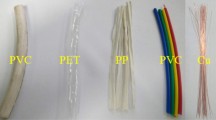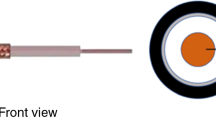Abstract
The effect of inorganic additive flame retardant on fire hazard of polyurethane exterior insulation material was experimentally investigated by the cone calorimeter (Cone) and thermal gravimetric–differential thermal analysis. The aluminum trihydrate (ATH) and magnesium hydroxide (MDH) were considered as the inorganic additive flame retardants in the experiments. The results indicated that compared to pure rigid polyurethane foam (RPUF), the RPUF containing inorganic flame retardant could significantly enhance fire resistance and thermal stability. Especially for RPUF, the ratio of MDH and ATH was 1:3, the ignition delay time was extended for about 14.33 s as well as the values of peak heat release rate and the total heat release were reduced by about 50.79 kW m−2 and 2.60 MJ m−2. Also, the peak values of the carbon monoxide release rate were decreased to 0.0096 g s−1. Further, the decomposition process of the RPUFs in nitrogen and air was compared and analyzed. It was found that they could be divided into two stages and three stages, respectively, and small fluctuations of the second stage in air were corresponded to the decomposition of ATH and MDH. Besides, the compressive properties were proved to decrease with the increased additive amount of the metal hydroxides. Based on the experimental results and the classic dynamics methods, the activation energy (Eα) and the pre-exponential factor (A) were obtained and it turned out that the addition of inorganic flame retardant could enlarge the values of Eα and A, which helped to reduce the fire hazard.







Similar content being viewed by others
References
Al-Homoud MS. Performance characteristics and practical applications of common building thermal insulation materials. Build Environ. 2005;40:353–66.
Demharter A. Polyurethane rigid foam, a proven thermal insulating material for applications between + 130 °C and − 196°C. Cryogenics. 1998;38:113–7.
Cabeza LF, Castell A, Medrano M, Martorell I, Pérez G, Fernández I. Experimental study on the performance of insulation materials in mediterranean construction. Energy Build. 2010;42:630–6.
Guo SR. The application and developmental trend of exterior wall external insulation. Applied mechanics and materials. Trans Tech Publ. 2012;174:1367–71.
Cinelli P, Anguillesi I, Lazzeri A. Green synthesis of flexible polyurethane foams from liquefied lignin. Eur Polym J. 2013;49:1174–84.
de Mello D, Pezzin SH, Amico SC. The effect of post-consumer PET particles on the performance of flexible polyurethane foams. Polym Test. 2009;28:702–8.
Hartter DR. The use and importance of nitroaromatic chemicals in the chemical industry. In: Rickert DE, editor. Toxicity of Nitroaromatic Compounds. Chemical Industry Institute of Toxicology Series. New York: Hemisphere Publishing; 1985. p. 1–13.
Hirschler M. Polyurethane foam and fire safety. Polym Adv Technol. 2008;19:521–9.
Usta N. Investigation of fire behavior of rigid polyurethane foams containing fly ash and intumescent flame retardant by using a cone calorimeter. J Appl Polym Sci. 2012;124:3372–82.
Singh H, Jain A. Ignition, combustion, toxicity, and fire retardancy of polyurethane foams: a comprehensive review. J Appl Polym Sci. 2009;111:1115–43.
Shi L, Li ZM, Xie BH, Wang JH, Tian CR, Yang MB. Flame retardancy of different-sized expandable graphite particles for high-density rigid polyurethane foams. Polym Int. 2006;55:862–71.
Tang Z, Maroto-Valer MM, Andrésen JM, Miller JW, Listemann ML, McDaniel PL, et al. Thermal degradation behavior of rigid polyurethane foams prepared with different fire retardant concentrations and blowing agents. Polymer. 2002;43:6471–9.
Meng XY, Ye L, Zhang XG, Tang PM, Tang JH, Ji X, et al. Effects of expandable graphite and ammonium polyphosphate on the flame-retardant and mechanical properties of rigid polyurethane foams. J Appl Polym Sci. 2009;114:853–63.
Ye L, Meng X-Y, Ji X, Li Z-M, Tang J-H. Synthesis and characterization of expandable graphite-poly (methyl methacrylate) composite particles and their application to flame retardation of rigid polyurethane foams. Polym Degrad Stab. 2009;94:971–9.
Singh H, Jain A, Sharma T. Effect of phosphorus-nitrogen additives on fire retardancy of rigid polyurethane foams. J Appl Polym Sci. 2008;109:2718–28.
Andre F, Cusack P, Monk A, Seangprasertkij R. The effect of zinc hydroxystannate and zinc stannate on the fire properties of polyester resins containing additive-type halogenated flame retardants. Polym Degrad Stab. 1993;40:267–73.
Schwarcz M, Cocuzza AC, Van Der Beck RR. Antimony trioxide inorganic compound glass flame retardant compositions and methods for their preparation. U.S. Patent Application. 1971.
Liang S, Neisius NM, Gaan S. Recent developments in flame retardant polymeric coatings. Prog Org Coat. 2013;76:1642–65.
Lu S-Y, Hamerton I. Recent developments in the chemistry of halogen-free flame retardant polymers. Prog Polym Sci. 2002;27:1661–712.
Garba B. Effect of zinc borate as flame retardant formulation on some tropical woods. Polym Degrad Stab. 1999;64:517–22.
Pearce EM, Liepins R. Public health implications of components of plastics manufacture. Flame retardants. Environ Health Perspect. 1975;11:59.
Blount DH. Flame retardant porous plastics. U.S. Patent. 1998.
Rakotomalala M, Wagner S, Döring M. Recent developments in halogen free flame retardants for epoxy resins for electrical and electronic applications. Materials. 2010;3:4300–27.
Betts KS. New thinking on flame retardants. Environ Health Perspect. 2008;116:A210.
Troitzsch J. Flame retardant polymers current status and future trends. In: Macromolecular symposia, vol 74. Hüthig & Wepf Verlag; 1993. p. 125–35.
Laoutid F, Gaudon P, Taulemesse J-M, Cuesta JL, Velasco J, Piechaczyk A. Study of hydromagnesite and magnesium hydroxide based fire retardant systems for ethylene–vinyl acetate containing organo-modified montmorillonite. Polym Degrad Stab. 2006;91:3074–82.
Shen KK, Kochesfahani S, Jouffret F. Zinc borates as multifunctional polymer additives. Polym Adv Technol. 2008;19:469–74.
Nyambo C, Songtipya P, Manias E, Jimenez-Gasco MM, Wilkie CA. Effect of MgAl-layered double hydroxide exchanged with linear alkyl carboxylates on fire-retardancy of PMMA and PS. J Mater Chem. 2008;18:4827–38.
Manzi-Nshuti C, Songtipya P, Manias E, Jimenez-Gasco MM, Hossenlopp JM, Wilkie CA. Polymer nanocomposites using zinc aluminum and magnesium aluminum oleate layered double hydroxides: effects of LDH divalent metals on dispersion, thermal, mechanical and fire performance in various polymers. Polymer. 2009;50:3564–74.
Sain M, Park S, Suhara F, Law S. Flame retardant and mechanical properties of natural fibre-PP composites containing magnesium hydroxide. Polym Degrad Stab. 2004;83:363–7.
Markarian J. Mineral modifiers fill the gap-keeping costs down without losing quality. Plast Addit Compd. 2007;9:20–5.
Xu J, Zhang C, Qu H, Tian C. Zinc hydroxystannate and zinc stannate as flame-retardant agents for flexible poly (vinyl chloride). J Appl Polym Sci. 2005;98:1469–75.
Weil ED, Levchik SV. Flame retardants in commercial use or development for polyolefins. J Fire Sci. 2008;26:5–43.
Baillet C, Delfosse L. The combustion of polyolefins filled with metallic hydroxides and antimony trioxide. Polym Degrad Stab. 1990;30:89–99.
Wang L, Su S, Chen D, Wilkie CA. Variation of anions in layered double hydroxides: effects on dispersion and fire properties. Polym Degrad Stab. 2009;94:770–81.
Wang Z, Qu B, Fan W, Huang P. Combustion characteristics of halogen—free flame—retarded polyethylene containing magnesium hydroxide and some synergists. J Appl Polym Sci. 2001;81:206–14.
Kim J, Lee J-H, Kim S. Estimating the fire behavior of wood flooring using a cone calorimeter. J Therm Anal Calorim. 2011;110:677–83.
Chen X, Jiao C, Zhang J. Microencapsulation of ammonium polyphosphate with hydroxyl silicone oil and its flame retardance in thermoplastic polyurethane. J Therm Anal Calorim. 2011;104:1037–43.
Vyazovkin S, Chrissafis K, Di Lorenzo ML, Koga N, Pijolat M, Roduit B, et al. ICTAC Kinetics Committee recommendations for collecting experimental thermal analysis data for kinetic computations. Thermochim Acta. 2014;590:1–23.
Standard A. D6641/D6641M-14. standard test method for compressive properties of polymer matrix composite materials using a combined loading compression (CLC) Test Fixture ASTM International W Conshohocken. 2014.
Vyazovkin S, Burnham AK, Criado JM, Pérez-Maqueda LA, Popescu C, Sbirrazzuoli N. ICTAC Kinetics Committee recommendations for performing kinetic computations on thermal analysis data. Thermochim Acta. 2011;520:1–19.
Ozawa T. Estimation of activation energy by isoconversion methods. Thermochim Acta. 1992;203:159–65.
Kada-Benameur H, Wirquin E, Duthoit B. Determination of apparent activation energy of concrete by isothermal calorimetry. Cement Concrete Res. 2000;30:301–5.
Beyer G. Flame retardant properties of EVA—nanocomposites and improvements by combination of nanofillers with aluminium trihydrate. Fire Mater. 2001;25:193–7.
Beyer G. Nanocomposites: a new class of flame retardants for polymers. Plast Addit Compd. 2002;4:22–8.
Pielichowski K, Flejtuch K. Non-oxidative thermal degradation of poly (ethylene oxide): kinetic and thermoanalytical study. J Anal Appl Pyrol. 2005;73:131–8.
Niemelä K. Oxidative and non-oxidative alkali-catalysed degradation of L-ascorbic acid. J Chromatogr A. 1987;399:235–43.
Bartyzel A, Kaczor AA, Gluchowska H, Pitucha M, Wrobel TM, Matosiuk D. Thermal and spectroscopic studies of 2, 3, 5-trisubstituted and 1, 2, 3, 5-tetrasubstituted indoles as non-competitive antagonists of GluK1/GluK2 receptors. J Therm Anal Calorim. 2018;133:935–44.
Cuinica LG, Macêdo RO. Thermoanalytical characterization of plant drug and extract of Urtica dioica L. and kinetic parameters analysis. J Therm Anal Calorim. 2018;133:591–602.
El-Basuony SA, Sadek MA, Wafy TZ, Mostafa HE. Thermokinetic studies of polyurethanes based on hydroxyl-terminated polybutadiene prepolymer. J Therm Anal Calorim. 2018;131:2013–9.
Ciecierska E, Jurczyk-Kowalska M, Bazarnik P, Kowalski M, Krauze S. The influence of carbon fillers on the thermal properties of polyurethane foam. J Therm Anal Calorim. 2016;123:283–91.
Yoshitake N, Furukawa M. Thermal degradation mechanism of α, γ-diphenyl alkyl allophanate as a model polyurethane by pyrolysis-high-resolution gas chromatography/FT-IR. J Anal Appl Pyrol. 1995;33:269–81.
Camino G, Duquesne S, Delobel R, Eling B, Lindsay C, Roels T. Polyurethanes-8 mechanism of expandable graphite fire retardant action in polyurethanes. ACS Symp Ser. 2001;797:90–109.
Duquesne S, Le Bras M, Bourbigot S, Delobel R, Camino G, Eling B, Roels T. Thermal degradation of polyurethane and polyurethane/expandable graphite coatings. Polym Degrad Stab. 2001;74:493–9.
Acknowledgements
This work is supported by the National Key Research and Development Plan (Projects No. 2016YFC0801500) and the Fundamental Research Funds for the Central Universities (No. WK2320000036). These supports are gratefully acknowledged.
Author information
Authors and Affiliations
Corresponding authors
Rights and permissions
About this article
Cite this article
Chai, H., Duan, Q., Jiang, L. et al. Effect of inorganic additive flame retardant on fire hazard of polyurethane exterior insulation material. J Therm Anal Calorim 135, 2857–2868 (2019). https://doi.org/10.1007/s10973-018-7797-3
Received:
Accepted:
Published:
Issue Date:
DOI: https://doi.org/10.1007/s10973-018-7797-3




